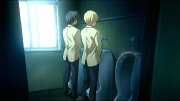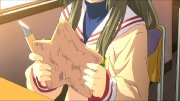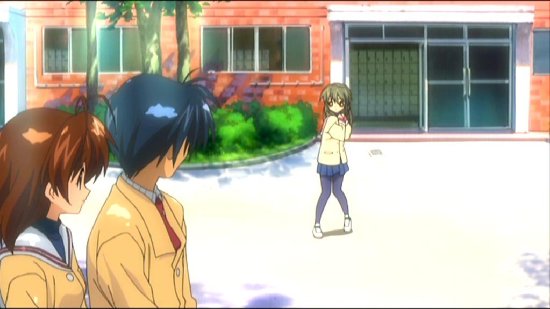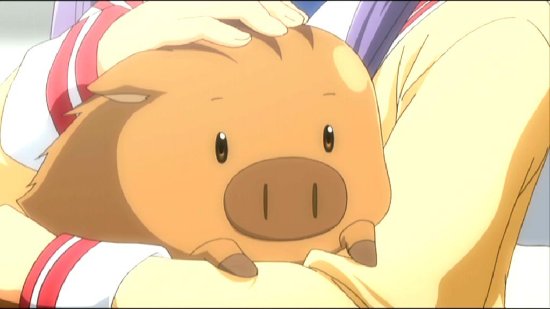Review for Clannad: Series 1 Part 1
Introduction
Although we don't get all the anime in the UK that is released to the rest of the English speaking world, we do get a fair sampling of all that is out there. We have some shonen action shows, we have sci-fi, we have romance, and we even have the occasional sports anime. Vampires, ghosts, ninja, samurai, there's something to suit all appetites and all persuasions if you look long and hard enough. But if there is one glaring omission from the UK scene, it's the Key/Visual Arts anime. It isn't too surprising, given that they aren't exactly prolific. Practically all of their shows are animated by Kyoto Animation, which leads to a lot of KyoAni and KeyAni confusion, at least on my part. But what you need to know about the Key/Visual Arts anime shows is that they are adapted from visual novels, interactive videogames, which let you live the life of a male protagonist surrounded by a harem of females.
These games aren't what you would call family friendly, although you wouldn't guess that from the anime that are adapted from them. What's striking is the formula that these anime have established; making the KeyAni shows practically a genre in their own right. In these shows, there is usually a young male protagonist with a dark, damaged past. During the course of the series, he meets and gets involved with several girls, encompassing the whole spectrum of the young girl anime stereotypes, and all with mysteries of their own to be unravelled over the course of the story. We start off with a whole lot of comedy with just a hint of tragedy, and as the series progresses, the tragedy intensifies as the story gets darker and darker, and the secrets of the characters are revealed. KeyAni shows will entertain you, and then break your heart, and if you can look past the obvious clichés and tropes, and the formula, and let yourself be enchanted by the characters, you'll even be grateful for it. What makes it work is that the characters are all very appealing, while Kyoto Animation's world design, character designs, and use of light and warmth in realising the animation, makes every frame a delight. I got tired of waiting for one of these shows to come to the UK, and I imported Kanon a few years back, one of ADV's final releases (later re-released by Funimation). I loved every second of it, despite having read about, and been prepared for its formula.
It seems that ADV has a monopoly on Key/Visual Arts shows, and have over the years released Air, both the movie and the TV show, the second Kanon series (the first never saw a Western release), and ADV's successor Sentai Filmworks has picked up two other major shows from Key. This year, Manga Entertainment are bringing those shows to the UK, and in one fell swoop giving us more than half of the Key/Visual Arts catalogue. Key served as a producer on the forthcoming Angel Beats anime although that isn't a Key/Visual Arts game, but one of their games to be adapted is coming here in the form of two full length series, Clannad, and its sequel Clannad After Story. I get to look at the first half of Clannad in this review.
Tomoya Okazaki is the young boy with a dark past. His relationship with his alcoholic father has degenerated into total non-communication, and this has affected his school life to such a degree that he's considered a delinquent, along with his best friend Youhei Sunohara. Delinquency in this case means just going through the motions at school, turning up because there is nothing better to do, and spending the day staring aimlessly out of the window. His life begins to change however when he meets something of a kindred spirit. Nagisa Furukawa is also an outcast at school, although in her case it's not through choice. She's been ill for the past year, and is now repeating her classes. Shy and timid, she hasn't made any friends in the new school year, and hardly anyone is aware of her existence. But chatting to Tomoya helps her open up, and she reveals a passion for drama. When Tomoya decides to help her reopen the school's drama club, it sparks off a chain of events that leads him to meet some very remarkable girls at school, and come face to face with some unsettling mysteries.
The first twelve episodes of Clannad are presented across three discs from Manga Entertainment.
Disc 1
1. On a Slope with Falling Cherry Blossoms
2. The First Step
3. Once More After the Tears
4. Looking For Friends
Disc 2
5. Scene with Sculptures
6. The Sisters' Founder's Festival
7. Star-shaped Feelings
8. The Breeze Fading at Dusk
Disc 3
9. Until the End of the Dream
10. The Girl Genius' Challenge
11. Afterschool Rhapsody
12. Hidden World
Picture
Clannad gets a 1.78:1 anamorphic transfer, which courtesy of Australia's Siren Visual is a native PAL transfer with the 4% speedup that implies. The image is clear and sharp throughout, the animation is smooth and free of compression artefacts, and watching these episodes I had no cause for complaint. The animation is gorgeous. If you've seen any anime from studio KyoAni, such as The Melancholy of Haruhi Suzumiya, then you'll know how much effort they put into creating consistent and appealing world and character designs. Just like Key/Visual's Kanon before it, Clannad too creates and idealised, warm and sympathetic world, using colours, light and atmosphere to draw the viewer in, and filling the world with cute and charming character designs. Watching an episode of Clannad is like spending 20 minutes in a sweet shop. It's an animation that just glows.
Again, I can't reiterate how much I appreciate anime being made available for UK consumers this way, as it now makes full use of the greater 576 line resolution of PAL, with a sharper image. Also with the playback at 25 frames per second, there's no ghosting or judder or any of the associated issues with interpolating NTSC to PAL as in older anime transfers. Also I find that playing back native NTSC content on UK equipment is nice enough, but does tend to show interlacing artefacts which I never see on PAL transfers. That indicates just how much I appreciate Clannad on these three dual layer discs. For many it is a matter of disappointment that Clannad's US Blu-rays couldn't be brought to the UK, but given Manga Entertainment's woes in releasing long series on the expensive format it is an understandable choice. It's worth noting that Clannad hasn't even been released on Blu-ray yet in Australia's far more amenable anime market.
Sound
You have the choice between DD 2.0 English and DD 2.0 Japanese, and this being a Siren sourced disc, the audio will default the Japanese. Of course you have the optional translated subtitles and a signs only track. I went with the original language audio, and was very happy with the actor performances and the overall experience. Clannad gets a very agreeable music soundtrack (apart from the violin), with some very nice theme songs, and incidental music that suits the story perfectly. I tried the English dub, and couldn't bear more than ten minutes of it. It's one where the voice actresses try to emulate the original performances too closely, and it always sounds forced to me and unnatural. Of course your mileage may vary.
If there is an issue here it's with the translated subtitle stream, and the way it handles the captions that translate onscreen text. Rather than have them appear separately at the top of the screen, or overlaying the text to be translated, Siren have made them part of the subtitle stream, and they appear during the flow of the dialogue, at the same location on the screen, in the same font. It can be confusing when it happens during dialogue, as it can appear to be part of the conversation, and it takes a second to grasp that it's actually translating on screen text. Also, as it's in the subtitle stream, it very rarely stays up long enough to register, and on occasion I did have to skip back to take it in again. Of course this isn't an issue if you're watching the English dub with the signs only track.
Extras
Three discs come with static menus, and a language select option. You have to play the episodes one by one. There is no Play All Option. Each episode ends with an extra 90-second English language credit reel over a black background.
There are no extra features with this collection.
Conclusion
I feel that I should repeat my review for Kanon, except with better weather, as that series was set during winter. Actually, it's something of a blessing that Clannad is the first Key/Visual Arts anime to be released in the UK, as not everyone will be familiar with the storytelling style, making it a fresh and original experience. If you have seen Kanon or Air however, you may find that familiarity lessens the experience, provides a familiar touchstone, or makes no difference whatsoever. I must admit that at one point I did have a Kanon flashback that threw me out of Clannad for a minute, but it was a short thing. One thing that I will say about Clannad, that it has in common with its predecessor, is that it's a show that requires that the viewer make a bargain with it to best enjoy it. You have to accept the unreality of its world, the fantastic elements, the very deliberate storytelling design, and the utterly appealing, yet utterly clichéd character tropes. The viewer has to meet the show halfway, suspend more than the usual measure of disbelief, and be an active conspirator in having his or her emotions manipulated, to fully appreciate the show. The minute you view Clannad with a cynical or sceptical eye, it will lose you. Fortunately, the visual aesthetics of the animation, the very appealing character designs, the utterly charming slice of life comedy, and the quirky, yet engaging characters will do much to disarm you, making that suspension of disbelief easy indeed.
The similarity to Kanon is immediately apparent, with Tomoya Okazaki the central male figure in the anime, the good natured, friendly guy, who happens to be the class delinquent because of his dark past, his fraught relationship with his alcoholic father. It's a relationship that has had more than just a psychological effect on him, as becomes clear in the story. While his home life is less than ideal, he at least has a best friend in Youhei Sunohara, a fellow delinquent who lives in a student dorm, and where we can often find Tomoya in his free time. But, while Tomoya may try to drift his way through high school, there are girls that like the 'bad boy' and he still gets more than his fair share of attention, mostly from the timid class rep Ryou Fujibayashi, and her protective sister Kyou. Meanwhile Sunohara soon finds a combat challenge in the toughest girl in the school, prospective school president Tomoyo Sakagami, and is soon getting his backside battered on a regular basis. Sunohara is eager, and lusts after female attention, whereas Tomoya is more prone to tease girls good-naturedly than to flirt with them.
Tomoya's life begins to change when rumours start going around school of a ghostly girl, the spirit of a car accident victim. At the same time, Ryou performs a tarot reading for Tomoya, and tells him that he's going to meet a strange girl the next day. Sure enough, the next day he encounters Nagisa Furukawa, and finds in her a kindred spirit. She's sitting isolated and alone during lunch, but unlike his self-imposed solitude, she's alone because of circumstance. She's been absent from school for a year, and is now repeating, which means that no-one in her year recognises her, and her shyness and introverted nature makes it hard for her to make friends. Beneath the shy surface though, Tomoya learns that Nagisa wants to be more outgoing, and even has a passion for drama. She wants to re-start the school's drama club, gather a group of interested school mates, and put on plays. Tomoya decides to help her do this, and this plot thread grows through the episodes. We learn more about Nagisa, and Tomoya also meets her oddball parents who run the town's bakery. Nagisa's mother is always experimenting with new baked goods, and sees in Tomoya a likely guinea pig, while her father is quick to tease him.
It's easy to see that the storyline with Nagisa will persist to the end of the show, and will develop over the episodes taking its time to be resolved. But this being a harem show, there are plenty of other girls for Tomoya to encounter, all of whom have their own mysteries and personality quirks to bring to the table. First after Nagisa is Fuko Ibuki, who Tomoya encounters carving away in the school's art room. She's making starfishes, to give to the student body as invitations to her older sister's forthcoming wedding. Fuko is short, incredibly cute, childlike, and a little defensive and forthright. She instantly pegs Tomoya as a 'weird' kid, but despite an initial wariness of him, soon comes to like him. But with Fuko comes a whole heap of mysteries, not least the fact that she appears to live at the school, spends all her time making her starfishes, and doesn't attend lessons. It also looks as if the rest of the school isn't aware of who she is. Tomoya and Fuko take her to their hearts though, and decide to help her make her starfishes, and invite as many people as possible to her sister's wedding. At the same time, Tomoya and Nagisa try and learn more about Fuko's sister Kouko, and in turn learn the truth behind Fuko's mission.
Then there is another class absentee, Kotomi Ichinose, although her absence from class is down to her being a genius. She's got permission to spend her days in the school library, and that's where Tomoya finds her, buried behind a pile of books. She's also cute and introverted, but her lack of social skills comes less from shyness than it does from inexperience. Tomoya tries to help her make some friends, and bring her out of her shell, although that may be a mistake when it transpires that she loves to play the violin. She's no good at it, but she loves to play it, and wants to perform for her classmates. But again, mystery and tragedy intrudes, as Tomoya learns that he actually has a shared past with Kotomi, and there's a reason behind her self-imposed seclusion in the library. It seems that coming out of the library may have awoken some buried demons for Kotomi, which is just the tantalising point at which this collection of episodes ends.
Just like Kanon, Clannad is a thoroughly engaging blend of tragedy and comedy. The comedy flows naturally from the light-hearted, slice of life side to the show. But as the various mysteries about the characters start to unfold, the tragic nature of their pasts is revealed and that humour turns to heartbreak. I've already shed manly tears once during this collection of episodes, and I'm sure that it will happen again and again as the series progresses. The characters are fascinating, the mysteries in their stories engrossing (there's also an occasional vignette of the last girl in the world and her robot that has yet to be explained), and the tragic elements tug at the heartstrings without mercy. Key/Visual Arts are masters at making this formula work, and Clannad works on every level. It's true that you have to work with it, but that is far from a chore. This type of anime is new to the UK scene, and it fills a gap on your anime shelf that you may not even know you have. Recommended.












































































Your Opinions and Comments
Be the first to post a comment!